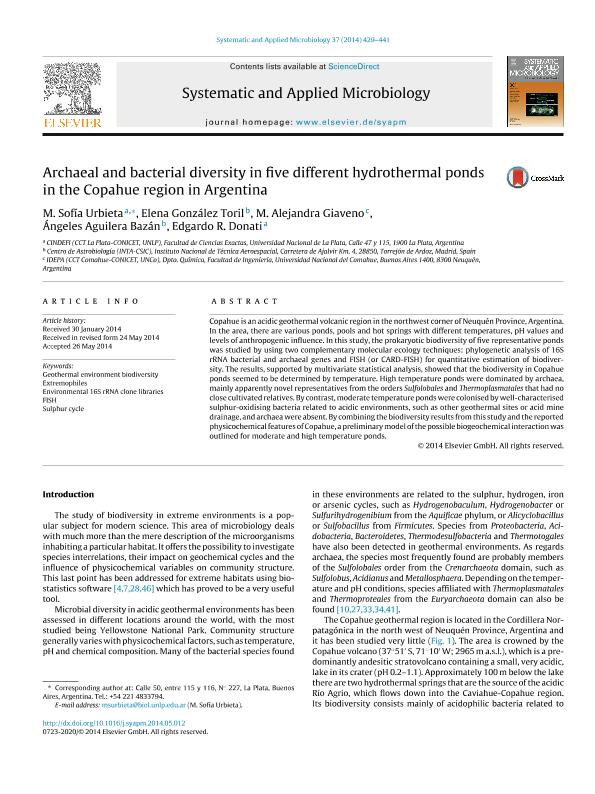Artículo
Archaeal and bacterial diversity in five different hydrothermal ponds in the Copahue region in Argentina
Urbieta, María Sofía ; Gonzalez Toril, Elena; Giaveno Filippa, María Alejandra; Aguilera Bazán, A; Donati, Edgardo Ruben
; Gonzalez Toril, Elena; Giaveno Filippa, María Alejandra; Aguilera Bazán, A; Donati, Edgardo Ruben
 ; Gonzalez Toril, Elena; Giaveno Filippa, María Alejandra; Aguilera Bazán, A; Donati, Edgardo Ruben
; Gonzalez Toril, Elena; Giaveno Filippa, María Alejandra; Aguilera Bazán, A; Donati, Edgardo Ruben
Fecha de publicación:
09/2014
Editorial:
Elsevier Gmbh
Revista:
Systematic And Applied Microbiology
ISSN:
0723-2020
Idioma:
Inglés
Tipo de recurso:
Artículo publicado
Clasificación temática:
Resumen
Copahue is an acidic geothermal volcanic region in the northwest corner of Neuquén Province, Argentina. In the area, there are various ponds, pools and hot springs with different temperatures, pH values and levels of anthropogenic influence. In this study, the prokaryotic biodiversity of five representative ponds was studied by using two complementary molecular ecology techniques: phylogenetic analysis of 16S rRNA bacterial and archaeal genes and FISH (or CARD-FISH) for quantitative estimation of biodiversity. The results, supported by multivariate statistical analysis, showed that the biodiversity in Copahue ponds seemed to be determined by temperature. High temperature ponds were dominated by archaea, mainly apparently novel representatives from the orders Sulfolobales and Thermoplasmatales that had no close cultivated relatives. By contrast, moderate temperature ponds were colonised by well-characterised sulphur-oxidising bacteria related to acidic environments, such as other geothermal sites or acid mine drainage, and archaea were absent. By combining the biodiversity results from this study and the reported physicochemical features of Copahue, a preliminary model of the possible biogeochemical interaction was outlined for moderate and high temperature ponds.
Archivos asociados
Licencia
Identificadores
Colecciones
Articulos(CINDEFI)
Articulos de CENT.DE INV EN FERMENTACIONES INDUSTRIALES (I)
Articulos de CENT.DE INV EN FERMENTACIONES INDUSTRIALES (I)
Citación
Urbieta, María Sofía; Gonzalez Toril, Elena; Giaveno Filippa, María Alejandra; Aguilera Bazán, A; Donati, Edgardo Ruben; Archaeal and bacterial diversity in five different hydrothermal ponds in the Copahue region in Argentina; Elsevier Gmbh; Systematic And Applied Microbiology; 37; 6; 9-2014; 429-441
Compartir
Altmétricas



